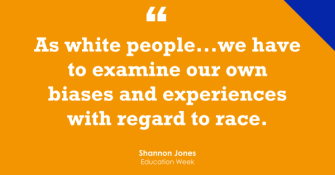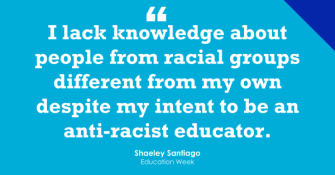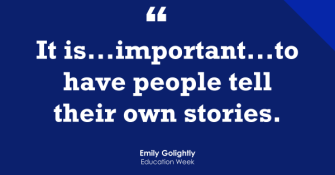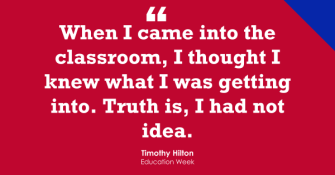(This is the second post in a three-part series. You can see Part One here.)
The new question-of-the-week is:
What books and articles should white educators read about race and racism?
In Part One, Tameka Porter, Ph.D., Dr. Denita Harris, Keisha Rembert, and Sara Boeck Batista offered their recommendations. Dr. Porter, Dr. Harris, and Keisha were guests on my 10-minute BAM! Radio Show. You can also find a list of, and links to, previous shows here.
Today, Shannon Jones, Shaeley Santiago, Emily Golightly, and Timothy Hilton share their suggestions.
We can’t wait for the “right time”
Shannon Jones is a 14-year educator working in Wheaton, Md. She is a focus teacher for students in 3rd through 5th grades. She can be reached at shannon.l.jones@mcpsmd.net or @MsJonesLuvsMath:
Conversations around race, racism, and implicit bias can be uncomfortable for white people who often fear they will say something that is harmful to Black, Indigenous, and People of Color (BIPOC). However, we are at an inflection point in our country’s history. It is no longer acceptable to wait for “the right time” to have hard discussions about race in our country. We can’t wait until people feel comfortable talking about race.
Right now in your school, there are behavior policies and tracking systems in place, curriculums being taught, and toxic teacher practices that are impeding our ability to achieve racial equity. To examine some concrete steps, I encourage you to read Paul Gorski’s article, “Avoiding Racial Equity Detours.”
As a white middle-class woman, I feel unqualified to talk to you about race. I am at the beginning of my journey and I do not have all the answers. Through conversation and research, I have learned one very important lesson. If you are silent because you fear you will say the “wrong” thing or fear that you will say something insensitive that sounds racist, then you aren’t allowing yourself to be open to feedback. I used to say with pride that I didn’t see color, that I loved all of my students. But in not seeing color, I was ignoring many important details about the lives of my students. I was ignoring how their color affected their experience, both in the classroom and out. When we worry about how others will judge us rather than shifting the focus to what we can do to improve our own racial lens, this is called “white fragility,” and you can examine your white fragility while reading White Fragility, a book by Robin DiAngelo.
To increase your comfort level when discussing race, consider reading So You Want to Talk About Race, a book by Ijeoma Oluo. Very recently in a conversation about current police events in the news, a good friend of mine stated, “Well there is racism on both sides.” In the past, this statement wouldn’t have sat right with me, but I might have nodded my head along to the conversations because I did not have a counter-argument. Reading So You Want to Talk About Race has given me the knowledge to highlight the falsehoods in these types of statements.
Our current media focuses much of its attention on the actions of Black males. Black females lack the representation of their male counterparts. Therefore, there is less literature concerning their struggles and how to best develop them as learners. According to Monique Morris, educators are more likely to assign adultlike characteristics to young Black girls. This is called “age compression,” and this perception leads educators to translate frequent questions or expressions of frustration from Black girls as “attitude,” sass, or aggression. Pushout: The Criminalization of Black Girls in School is a book by Monique W. Morris, and it is particularly great for white educators because it focuses a lot on what we can be doing at the school level to combat our biases as educators.
As educators, it is not enough just to love our students. As white people, we can often believe that “not being racist” is enough. In order to be better allies for our students and co-workers of color, we have to examine our own biases and experiences with regard to race. We have to reflect on our white privilege. Me and White Supremacy: Combat Racism, Change the World, and Become a Good Ancestor, a book by Layla F Saad, offers daily readings and journal prompts. These journal prompts will help you do the work to scrutinize your past, who you are as a person and as a teacher. Your thoughts and prior experiences are being reflected in your choices and actions.
Some additional texts that I would recommend include: The Impact of Identity in K-8 Mathematics by Danny Bernard Martin, Julia Aguirre, and Karen Mayfield-Ingram; We Want to Do More Than Survive by Bettina L. Love; Unconscious Bias in Schools by Tracey A. Benson and Sara E. Fiarman; and The Guide for White Women Who Teach Black Boys by Eddie Moore Jr., Ali Michael, and Marguerite W. Penick-Parks.

Working to be an “anti-racist educator”
Shaeley Santiago has been an EL teacher, instructional coach, strategist, and program coordinator for the Ames Community school district in Ames, Iowa, for over 15 years. She also teaches ESL endorsement classes at Drake University’s School of Education and is an officer for MIDTESOL:
As a white female educator (like the majority of U.S. educators), I have come to realize that I lack knowledge about people from racial groups different from my own despite my intent to be an anti-racist educator. While living alongside and cultivating friendships with people from diverse racial backgrounds is the ultimate action to change that, there is a wealth of information to be gained from reading, particularly #OwnVoices books written by Black, Indigenous, and People of Color (BIPOC).
I use my white privilege to center the voices of BIPOC authors by electing to focus only on books written or edited by authors who identify as nonwhite. I will start with books that address race and racism in a somewhat general context and move into ones that are specific to education.
So You Want to Talk about Race by Ijeoma Oluo is an accessible book in part because it is a collection of articles on race-related topics written specifically for white people. Don’t be fooled by the short chapters, though! They are full of deep thoughts worthy of highlighting, rereading, and discussing with friends.
How to Be an Antiracist by Ibram X. Kendi will push your thinking about race and racism. By telling his story interspersed with definitions of key terms and examples from historical and current events, Kendi challenges us to take action.
Courageous Conversations about Race: A Field Guide for Achieving Equity in Schools by Glenn E. Singleton shares a protocol for talking about race. The book contains racial autobiographies from contributors and many activities that can be used to apply the protocol with educators.
Overcoming the Achievement Gap Trap: Liberating Mindsets to Effective Change by Anthony Muhammad addresses the mindsets of educators. He posits that equitable outcomes in education will not be achieved until there is a cultural change in the beliefs, assumptions, and attitudes of educators.
Multiplication Is for White People: Raising Expectations for Other People’s Children by Lisa Delpit calls on teachers to be “warm demanders, holding high expectations for all of their students.” She gives numerous suggestions for how teachers can be more effective in their instructional practice including being courageous, learning humility, and looking and listening for who is missing.
For White Folks Who Teach in the Hood … And the Rest of Y’all Too: Reality Pedagogy and Urban Education by Christopher Emdin stresses the importance of providing a venue for #StudentVoice at the classroom level. Emdin incorporates elements from Black churches and hip-hop culture as he takes us through a structure for engaging “neoindigenous youth” in the educational process.
We Got This.: Equity, Access, and the Quest to Be Who Our Students Need Us to Be by Cornelius Minor is a practical book that emphasizes the need for teachers to deeply listen and hear what their students are telling them about relevant skills to address real-world circumstances.
Culturally Responsive Teaching and the Brain: Promoting Authentic Engagement and Rigor Among Culturally and Linguistically Diverse Students by Zaretta Lynn Hammond highlights brain research on strategies that promote equity in the classroom, particularly for students from diverse cultural and linguistic backgrounds. She gives practical tips for how teachers can supplement rigorous expectations with appropriate supports so students can experience success.
The Guide for White Women Who Teach Black Boys edited by Eddie Moore brings together the work of many authors who write about Black boys in schools and the critical role white women educators can play in ensuring Black student success.
We Want to Do More Than Survive: Abolitionist Teaching and the Pursuit of Educational Freedom by Bettina L. Love presents a challenging message about how education has stolen the souls of Black children, making them feel like they don’t matter. She also addresses intersectionality and how teachers should actively work to combat injustice.

"#OwnVoices”
Emily Golightly has taught for the past 16 years in North Carolina, serving as a classroom teacher in grades K-3, a reading specialist, an ESL teacher, and most recently, a media coordinator of a K-5 library. She is passionate about literacy and has served on her local and state-level reading associations:
Here are four recommendations:
1.The Hate U Give by Angie Thomas—This book helps give perspective on the environment and culture that is the reality for some families and students. It delves into the pain and emotional scarring that comes from a police shooting and how innocent children and communities can be impacted long term. It is also a beautiful story about family, and friendships, and their joys and complexities. It shares the story of Starr Carter, a young lady caught between two worlds, and not really feeling like she is fully a part of either—the elite private school she attends with primarily white students and her neighborhood, where her father runs a local grocery, and the community is poor but tightly knit.
2. Stamped: Racism, Antiracism, and You by Ibram X. Kendi and Jason Reynolds—The beautiful and brilliant premise of this book is that to understand racism today, we have to understand the history of racism and how we got here. This book digs into a multitude of historical events and how they have shaped our emotions, our beliefs, and our culture. This book is one I could not put down! There is a fantastic interview with the authors and Trevor Noah, digging into this book a little further, and I highly recommend it.
3. The Newcomers: Finding Refuge, Friendship, and Hope in an American Classroom by Helen Thorpe—This story is a nonfiction account following a class of high school newcomer English-learners in Colorado and was written by a reporter, not a teacher. This account shares the highs and lows of families from a variety of countries, cultures, faiths, and linguistic backgrounds, and is a beautiful example of what we do as teachers of English-learners...the joys, the celebrations of new skills and achievements, and the sorrow and fear of worrying about students’ home situations and challenges that sometimes feel insurmountable. As a teacher of English-learners, I found this book made me look at my students and their circumstances differently, and it gave me a tool in my toolbox for helping other people who may not understand these students and their families develop a newfound empathy and understanding.
4. Love, Hate, & Other Filters by Samira Ahmed—I read this book when it was featured on the Global Read Aloud book list several years back and believe teachers and students alike will find relevant connections to our current situation and this story. It deals with Islamophobia and the way that a crime hundreds of miles from Ahmed’s own home and neighborhood had the ability to totally shake up her sleepy little town. Another book of hers, Internment, is also a critical read, dealing with Muslim families being placed in internment camps in the not-so-distant future based on fear, politics, and racism.
I believe that these selections are important because they range from realistic fiction to history to nonfiction accounts to somewhat-dystopian fiction that all address similar themes and ideas but with a slightly different spin. Each of these books impacted me deeply and are books that I think back on often as works that have shaped me as an educator, parent, and human. There are SO many great works, and this is truly just the tip of the iceberg, but I do believe it is also important where possible to have people tell their own stories, so I appreciate works featuring authors of color, as sharing your own experience is vastly different from simply trying to understand and write about someone else’s experiences. #storiesmatter #ownvoices

“These two books changed my life”
Timothy Hilton is a climate and culture specialist with the Fresno Unified school district where he coaches teachers on classroom management and class climate. Timothy has over 10 years classroom teaching experience at every level of social studies ranging from Advanced Placement to English-language development:
When thinking about racism and race, I cannot help but think about my own journey to understand concepts that I was ignorant to for so many years. As a white educator, my understanding of race, racism, and privilege has been constantly changing. Considering my perspective as a white educator, I can only speak to my experience and which books change me the most. These books are:
Pivotol Moments: How educators can put all students on the path to college by Roberta Espinoza
And
The Trouble with Black Boys: and other reflections on race, equity, and the future of public education by Pedro A. Noguera
These two books opened my eyes to how I see my students, and what I can do to counter the years of systematic racism they have faced.
While I am currently in an out-of-classroom role, I spent 10 years in the classroom teaching in South Los Angeles and the Watts neighborhood of L.A. When I came into the classroom, I thought I knew what I was getting into. Truth is, I had not idea.
After years of learning by doing, and experiencing, I read Pedro Noguera’s book, The Trouble with Black Boys. This book opened my eyes to how the system keeps our students of color down by pulling no punches and speaking the hard truths that we do not often want to hear. Noguera speaks to the school to prison pipeline, academic achievement among African American boys, and how poverty plays into all of this. While his book speaks to the uncomfortable truth, his book also carries a constant theme of optimism that we can make changes. He speaks to the idea of changing discipline procedure (which is my current job) and investing in the social capital of our students (more on that later). Pedro Noguera puts the system into context, and all I can say is I wish I had read it earlier in my career.
On the topic of social capital, the next book I highly recommend was one that I read for my doctoral studies. This book, Pivotal Moments by Roberta Espinoza takes the concepts of Bourdieu and turns them into concrete examples of how we as educators can help our students break out of the class-driven outcomes they seem destined for. Espinoza writes about how we as educators can help our students ‘jump’ to the next level of class by leveraging our capital and our skills for them.
Do not mistake what I am saying as us doing stuff for them. Espinoza is very clear that leveraging our capital for our students is not about doing the work for them but about getting them the chance to do it themselves. A chance they may have never gotten due to an absence of social or cultural capital.
These two books changed my life. They changed not only how I saw my students, and how I can help them, but it also changed how I saw myself in the education system. These books forced me to take a strong look inside and question what I believed and what I stand for.
As I said, these books changed my life. I am sure they could do the same for you.

Thanks to Shannon, Shaeley, Emily, and Timothy for their contributions!
Please feel free to leave a comment with your reactions to the topic or directly to anything that has been said in this post.
Consider contributing a question to be answered in a future post. You can send one to me at lferlazzo@epe.org. When you send it in, let me know if I can use your real name if it’s selected or if you’d prefer remaining anonymous and have a pseudonym in mind.
You can also contact me on Twitter at @Larryferlazzo.
Education Week has published a collection of posts from this blog, along with new material, in an e-book form. It’s titled Classroom Management Q&As: Expert Strategies for Teaching.
Just a reminder; you can subscribe and receive updates from this blog via email (The RSS feed for this blog, and for all Ed Week articles, has been changed by the new redesign - new ones won’t be available until late January). And if you missed any of the highlights from the first nine years of this blog, you can see a categorized list below.
This Year’s Most Popular Q&A Posts
School Closures & the Coronavirus Crisis
Best Ways to Begin the School Year
Best Ways to End the School Year
Student Motivation & Social-Emotional Learning
Facing Gender Challenges in Education
Cooperative & Collaborative Learning
Teaching English-Language Learners
Entering the Teaching Profession
I am also creating a Twitter list including all contributors to this column
"wait" - Google News
January 18, 2021 at 08:14PM
https://ift.tt/38S2Cuq
'We Can't Wait Until People Feel Comfortable Talking About Race' (Opinion) - Education Week
"wait" - Google News
https://ift.tt/35qAU4J
https://ift.tt/2Ssyayj
Bagikan Berita Ini















0 Response to "'We Can't Wait Until People Feel Comfortable Talking About Race' (Opinion) - Education Week"
Post a Comment